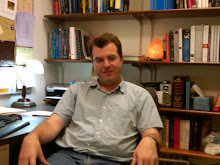Today I went to the physics student club room (a place where physics majors hang out and study and socialize) to drop off a few science magazines for them to read when they come back for fall quarter. On a table I found this poster from the American Physical Society:
(A bit of Googling did not turn up a digital version of the poster. If I find one I will link it.)
This looks like a pretty nice set of numbers for PhD employment. 64% in the private sector, 22% in potentially permanent academic jobs (which can be a sweet gig), and those in the private sector start at $92k. Sweet! What on earth could I be complaining about?
READ THE FINE PRINT!
Those numbers exclude postdoc positions and temporary academic jobs like adjuncting. What percentage of physics PhDs start off as postdocs or adjuncts? According to the American Institute of Physics, 65%. 56% go into postdoc positions, and another 9% go into other short-term positions. Now, most of them will eventually jump off of the postdoc/adjunct/visiting/etc. treadmill and find a full-time, long-term job that is reasonably satisfying. That's great. If APS wants to put those statistics out there, go for it. However, they instead chose to lie with statistics, and put a really rosy picture of PhD job outcomes in big print, while putting a partial caveat in fine print, and never mentioning at all that their data only applies to 1/3 of new PhD graduates.
Now, if APS were a commercial organization attempting to sell something, well, caveat emptor. The world is full of people telling incomplete stories. The fact that it's ubiquitous does not make it right, but it does make it rather unremarkable. There aren't enough hours in the day to blog about every misleading sales pitch ever made. APS, however, is not a commercial organization. APS is a non-profit professional society that exists to serve the physics community at all levels, including students. (Indeed, off-camera the poster includes a link to this student membership site.) Professional societies best serve their members when they provide their members with accurate data on careers and education. APS is not serving the interests of their student members when they provide misleading statistical information to people who are trying to decide what to do after college.
Now, to be fair, they did include some information about careers for people with bachelor's degrees in the second half of the poster:
(For some reason Blogger is making it possible to zoom in on the first image but not these two. I'm working on it. And yes, I'm aware of the irony of making the fine print visible in only one image while complaining about people who are sweeping things under the rug. I'll try to find a fix.)
The bottom figure certainly sells graduate school as The Path, by lumping graduate school, k-12 teaching, government jobs, and non-profit jobs in the same category. It is clearly a slanted poster. There's no good reason for this. It is left as an exercise for the reader to figure out why an organization that ostensibly exists to serve all of its members would target college students with misleading statistics that might influence their post-graduation decisions.
The bottom figure certainly sells graduate school as The Path, by lumping graduate school, k-12 teaching, government jobs, and non-profit jobs in the same category. It is clearly a slanted poster. There's no good reason for this. It is left as an exercise for the reader to figure out why an organization that ostensibly exists to serve all of its members would target college students with misleading statistics that might influence their post-graduation decisions.





